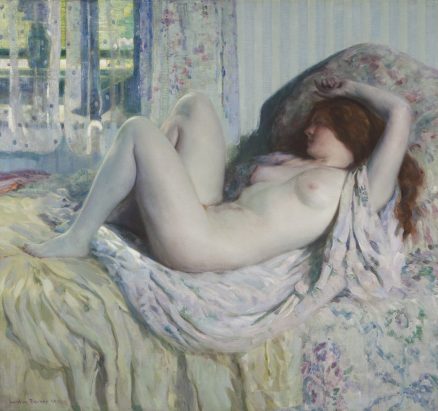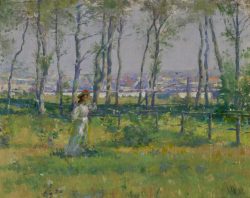- Categories
- Women
- Zoom in on Artwork
- Print Page
- Email Page to Friend
The nude woman in Lawton Parker’s La Paresse (“idleness”) reclines on a bed in full profile, one arm curved above her head in an attitude of indolence. Framed by her loose dark-red hair, the model’s face is shadowed and turned slightly away from the viewer, thereby highlighting by contrast the accessibility of her body. The cool pastels of the setting complement the pearly tones of her flesh, which are set off by the subtly vibrating surfaces of the variously patterned materials that surround her. The sunlit garden glimpsed through the casement window at the upper left is muted by diaphanous curtains. In this striking life-size image, the sinuous curves of the woman’s body render her situation—disrobed and prone in daytime—all the more suggestively erotic.
Parker executed La Paresse in the French village of Giverny, where he first worked in 1903. In Giverny Parker gradually abandoned the dark, tonal approach of his academic training and embraced the broken brushwork, bright color, and outdoor subjects of impressionism. He belonged to a group of American artists in Giverny—Karl Buehr and Pauline Palmer among them—who focused on picturing women at leisure, often out-of-doors. In company with his good friend Frederick Frieseke and his protégé Louis Ritman, Parker painted a number of nudes in the dappled sunshine of an enclosed garden or on riverbanks. He is said to have begun La Paresse when confined indoors by a rainstorm.
Parker synthesized disparate sources to create this modern interpretation of the classic subject of the reclining female nude. The academic training he received both in the United States and in Paris presumed the convincing portrayal of the human body, particularly the beautiful female form, as the ultimate form of artistic expression. In La Paresse, the model’s languorous pose, with legs drawn up and one arm flung over her head, recalls the seductive nudes of old master painters, notably Titian’s Danaë (1553–1554), which Parker knew firsthand from several visits to the Prado museum in Madrid. Parker’s use of decorative patterning throughout the image, on the other hand, reflects the influence of Post-Impressionism, particularly the paintings of the group of French artists known as the Nabis. The abundance of striped and floral designs surrounding the figure in La Paresse, as well as the harmonious palette of delicate blues, pinks, and lavender, characterize many of the interior compositions of Frieseke and Ritman, such as the latter’s Paris View.
La Paresse was one of Parker’s most widely exhibited and reviewed works. In the 1913 Paris Salon exhibition, it won the gold medal of the Société des Artistes Français, the highest award available to a foreigner. Even before the award was made, Sarah Hallowell, the Art Institute of Chicago’s agent in Paris, had selected the painting for the museum’s upcoming American art annual exhibition, where it was exhibited under the English title Idleness. Although the canvas arrived in Chicago too late for the awards competition, Art Institute director William M. R. French noted that in the exhibition “it excites a good deal of admiration[,] especially among the artists.”i In the 1914 Carnegie International exhibition in Pittsburgh, Parker’s masterpiece was omitted from the official catalogue and temporarily removed from display because of concerns about viewers’ reactions to the nudity. Between 1914 and 1921, La Paresse was shown in at least ten other major exhibitions and won two more prizes. It was reproduced as the frontispiece of a profile of the artist in the October 1915 issue of the short-lived Chicago journal The Art Student. Although Parker may well have had offers to purchase such a critically successful painting, La Paresse remained in his possession for the rest of his life.
Wendy Greenhouse, PhD
Donated by M. Christine Schwartz to the Florence Griswold Museum, Old Lyme, Connecticut, in 2023
i William M. R. French quoted in Richard Love, Louis Ritman: From Chicago to Giverny (Chicago: Haase-Mumm Publishing Company, Inc., 1989), 188.

